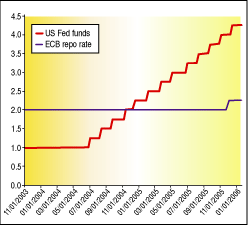FOREX FOCUS
Access to foreign exchange trading has opened up exciting trading options for the retail trader. You can now trade alongside corporations and institutions in a highly liquid market that is global, traded around the clock, and highly leveraged. Before jumping into this market, however, we must understand the factors that affect the forex market. With that in mind, STOCKS & COMMODITIES has introduced Forex Focus to better prepare the retail trader to participate in the currency market.
Where Will The US Dollar Find Support?
by Darrell Jobman
Monetary trends in the first quarter of 2006 may have the answer.
Monetary policy will remain very important for currency trends during the next few months, even if the markets give greater attention to the growing US trade deficit.
The exact timing of a peak in US interest rates is difficult to forecast, but there is a strong possibility that rates will peak in the first quarter of 2006. Thereafter, short-term US rates should not change very much for the remainder of 2006.
The European Central Bank (ECB) is likely to increase interest rates steadily during the year with a rate around 3.0% realistic by the end of 2006. The Bank of Japan is set to abandon its ultra-expansionary monetary policy during the first half of 2006, potentially in April, although interest rates will stay low.
Nominal yields will continue to favor the US dollar, but the gap relative to the euro and yen is unlikely to widen significantly further. In fact, spreads are likely to narrow from late in the second quarter, and with markets looking forward, the US dollar will find it more difficult to attract capital inflows. A benign series of events is possible, with the dollar settling into a trading range as interest rate differentials stabilize or narrow slowly. Of course, there is also still the risk of sharper dollar falls if the markets start to price in a quick US interest rate cut.
INTEREST RATE TREND CHANGES
Even if attention reverts to US structural issues, monetary policy and interest rates will remain an important determinant of exchange rates. Interest rate trends in the major economies, therefore, will remain a crucial market focus throughout 2006. It is particularly important to look at potential turning points in the monetary cycle, especially as these can also signal important changes in economic trends and currency direction.
The Federal Reserve continued to increase interest rates in 2005 at every meeting of the Federal Open Market Committee (FOMC). For the first 11 months of the year, there were no changes in the Eurozone or Japan (see Figure 1). As a result, the dollar secured support from widening interest rate differentials as higher US interest rates attracted funds into US securities and discouraged dollar selling.

FIGURE 1: SHORT-TERM INTEREST RATES. The Federal Reserve increased interest rates at every meeting of the Federal Open Market Committee (FOMC) during 2005. In the Eurozone there was only one interest rate increase during this time period.
Return to April 2006 Contents
Originally published in the April 2006 issue of Technical Analysis
of STOCKS & COMMODITIES magazine. All rights reserved.
© Copyright 2006, Technical Analysis, Inc.